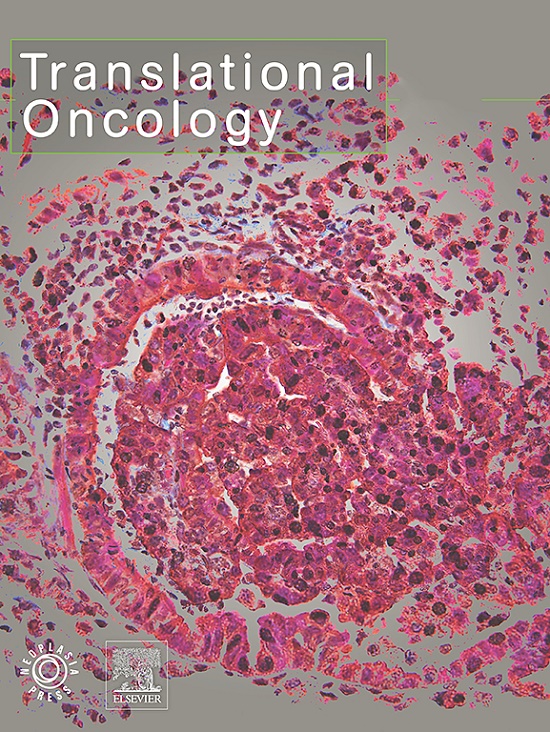Malignant phyllodes tumors with sarcomatous components: A histopathologic and molecular study
IF 5
2区 医学
Q2 Medicine
引用次数: 0
Abstract
Background
Malignant phyllodes tumors (MPTs) with sarcomatous components are often associated with substantial risks for local and distant recurrences. A more comprehensive characterization of their clinicopathological features and molecular profiles may offer significant potential innovative therapeutic strategies.
Methods
A total of ten cases were collected with eight cases undergoing DNA next-generation sequencing (NGS). The clinicopathological characteristics, prognostic information, and genomic profiles were compared to those of MPTs without sarcomatous components.
Results
Compared to MPT without sarcomatous components, no significant differences were found in age, tumor position, tumor size, menopausal status, or presence of fibroadenoma (p > 0.05). MPTs with osteosarcoma components had a poor prognosis either compared with other sarcomatous components (p = 0.027) or MPTs without sarcomatous components (p = 0.033). A notably high frequency of mutations was observed in several key genes within MPTs exhibiting sarcomatous components: TP53 (n = 6, 75.0 %), MUC16 (n = 4, 50.0 %), PTCH1 (n = 3, 37.5 %), and APC (n = 3, 37.5 %). In MPTs characterized by sarcomatous components, MCL1 (n = 6, 75.0 %) and MYC (n = 5, 62.5 %) demonstrated a notably high frequency of amplification. The NOTCH signaling pathway was significantly associated with MPTs characterized by sarcomatous components (13.6 % vs 75.0 %, p = 0.001).
Conclusions
The presence of an osteosarcoma component may serve as an indicator for unfavorable prognosis. Activating mutations in TP53 have been identified in these tumors. Furthermore, it typically facilitates tumor formation and progression via the NOTCH signaling pathway. These findings may offer valuable insights for clinical prognosis and identify potential therapeutic targets.
具有肉瘤成分的恶性叶状瘤:组织病理学和分子研究
背景:具有肉瘤成分的恶性叶状瘤(mpt)通常与局部和远处复发的巨大风险相关。对其临床病理特征和分子特征的更全面的描述可能会提供重要的潜在创新治疗策略。方法收集10例病例,其中8例进行DNA下一代测序(NGS)。将临床病理特征、预后信息和基因组谱与没有肉瘤成分的mpt进行比较。结果与不含肉瘤成分的MPT相比,年龄、肿瘤位置、肿瘤大小、绝经状态或纤维腺瘤的存在无显著差异(p >;0.05)。无论是与其他肉瘤成分相比(p = 0.027),还是与不含肉瘤成分的mpt相比(p = 0.033),伴有骨肉瘤成分的mpt预后都较差。在显示肉瘤成分的MPTs中,几个关键基因的突变频率明显较高:TP53 (n = 6, 75.0%)、MUC16 (n = 4, 50.0%)、PTCH1 (n = 3, 37.5%)和APC (n = 3, 37.5%)。在以肉瘤成分为特征的mpt中,MCL1 (n = 6, 75.0%)和MYC (n = 5, 62.5%)表现出明显的高频率扩增。NOTCH信号通路与以肉瘤成分为特征的mpt显著相关(13.6% vs 75.0%, p = 0.001)。结论骨肉瘤成分的存在可能是预后不良的一个指标。在这些肿瘤中已经发现了TP53的激活突变。此外,它通常通过NOTCH信号通路促进肿瘤的形成和进展。这些发现可能为临床预后和确定潜在的治疗靶点提供有价值的见解。
本文章由计算机程序翻译,如有差异,请以英文原文为准。
求助全文
约1分钟内获得全文
求助全文
来源期刊

Translational Oncology
ONCOLOGY-
CiteScore
8.40
自引率
2.00%
发文量
314
审稿时长
54 days
期刊介绍:
Translational Oncology publishes the results of novel research investigations which bridge the laboratory and clinical settings including risk assessment, cellular and molecular characterization, prevention, detection, diagnosis and treatment of human cancers with the overall goal of improving the clinical care of oncology patients. Translational Oncology will publish laboratory studies of novel therapeutic interventions as well as clinical trials which evaluate new treatment paradigms for cancer. Peer reviewed manuscript types include Original Reports, Reviews and Editorials.
 求助内容:
求助内容: 应助结果提醒方式:
应助结果提醒方式:


